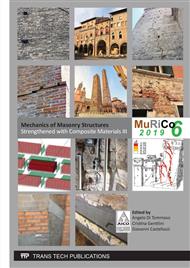[1]
G. Grüntal, R. Wahlström, The European-Mediterranean Earthquake Catalogue (EMEC) for the last millennium, J Seismol 16 (2012) 535-570.
DOI: 10.1007/s10950-012-9302-y
Google Scholar
[2]
P.G. Asteris, M.P. Chronopoulos, C.Z. Chrysostomou, H. Varum, V. Plevris, N. Kyriakides, V. Silva, Seismic vulnerability assessment of historical masonry structural systems, Engineering Structures 62-63 (2014) 118-134.
DOI: 10.1016/j.engstruct.2014.01.031
Google Scholar
[3]
M. Tomaževič, Eartquake-resistant design of masonry buildings, Series on Innovation in Structures and Construction – Vol 1, Imperial College Press, London, (1999).
Google Scholar
[4]
A. D'Ambrisi, F. Focacci, A. Caporale, Strengthening of masonry-unreinforced concrete railway bridges with PBO-FRCM materials, Composite Structures 102 (2013) 193-204.
DOI: 10.1016/j.compstruct.2013.03.002
Google Scholar
[5]
RILEM Technical Committee (W. Brameshuber), Recommendation of RILEM TC 232-TDT: test methods and design of textile reinforced concrete, Materials and Structures 49 (2016) Nr.5.
DOI: 10.1617/s11527-016-0839-z
Google Scholar
[6]
G. De Felice, M.A .Aiello, C. Caggegi, F. Ceroni, S. De Santis, E. Garbin, N. Gattesco, L. Hojdys, P. Krajewsky, A. Kwiecien, M. Leone, G.P. Lignola, C. Mazzotti, D. Oliveira, C. Papanicolau, C. Poggi, T. Triantafillou, M.R. Valluzzi, A. Viskovic, Recommendation of RILEM Technical Committee 250-CSM: Test method for Textile Reinforced Mortar to substrate bond characterization, Materials and Structures 2018 51:95.
DOI: 10.1617/s11527-018-1216-x
Google Scholar
[7]
C. Caggegi, F.G. Carozzi, S. De Santis, F. Fabbrocino, F. Focacci, L. Hojdys, E. Lanoye, L. Zuccarino, Experimental analysis on tensile and bond properties of PBO and aramid fabric reinforced cementitious matrix for strengthening masonry structures, Composites Part B 127 2017 175-195.
DOI: 10.1016/j.compositesb.2017.05.048
Google Scholar
[8]
F.G. Carozzi, A. Bellini, T. D'Antino, G. de Felice, F. Focacci, L. Hojdys, L. Laghi, E. Lanoye, F. Micelli, M. Panizza, C. Poggi, Experimental investigation of tensile and bond properties of Carbon-FRCM composites for strengthening masonry elements, Composites Part-B 128 2017 100-119.
DOI: 10.1016/j.compositesb.2017.06.018
Google Scholar
[9]
G.P. Lignola, C. Caggegi, F. Ceroni, S. De Santis, P. Krajewsky, P.B. Lourenço, M. Morganti, C. Papanicolaou, C. Pellegrino, A. Prota, L. Zuccarino, Performance assessment of basalt FRCM for retrofit applications on masonry, Composites Part B 128 2017 1-18.
DOI: 10.1016/j.compositesb.2017.05.003
Google Scholar
[10]
M. Leone, M. A. Aiello, A. Blasamo, F.G. Carozzi, F. Ceroni, M. Corradi, M. Gams, E. Garbin, N. Gattesco, P. Krajewski, C. Mazzotti, D. Oliveira, C. Papanicolaou, G, Ranocchiai, F. Roscini, D. Saenger, Glass fabric reinforced cementitious matrix: Tensile properties and bond performance on masonry substrate, Composites Part B 127 (2017) 196-214.
DOI: 10.1016/j.compositesb.2017.06.028
Google Scholar
[11]
G. Marcari, M. Basili, F. Vestroni, Experimental investigation of tuff masonry panels reinforced with surface bonded basalt textile-reinforced mortar, Composites Part B 108 2017 131-142.
DOI: 10.1016/j.compositesb.2016.09.094
Google Scholar
[12]
S.L. Sagar, V. Singhal, D.C. Rai, M. ASCE, P. Gudur, Diagonal shear out-of-plane flexural strength of fabric-reinforced cementitious matrix-strengthened masonry walls, Journal of Composite Constructions 10.1061/(ASCE)CC.1943-5614.0000796.
DOI: 10.1061/(asce)cc.1943-5614.0000796
Google Scholar
[13]
O.A. Cevallos, R.S. Olivito, Effects of fabric parameters on the tensile behaviour of sustainable cementitious composites, Composites Part B 69 (2015) 256-266.
DOI: 10.1016/j.compositesb.2014.10.004
Google Scholar
[14]
G. Ferrara, M. Pepe, E. Martinelli, R.D. Toledo Filho, Influence of an impregnation treatment on the morphology and mechanical behaviour of flax yarns embedded in hydraulic lime mortar, Fibers 7(4) (2019) 30.
DOI: 10.3390/fib7040030
Google Scholar
[15]
S.R. Ferreira, F. de Andreade Silva, P.R.L. Lima, R.D. Toledo Filho, Effect of hornification on the structure, tensile behaviour and fiber matrix bond sisal, jute and curaua fiber cement based composite systems, Construction and Building Materials 139 (2017) 155-161.
DOI: 10.1016/j.conbuildmat.2016.10.004
Google Scholar
[16]
R. Codispoti, D.V. Oliveira, R.S. Olivito, P.B. Lourenco, R. Fangueiro, Mechanical performance of natural fiber-reinforced composites for the strengthening of masonry, Composites Part B 77 (2015) 74-83.
DOI: 10.1016/j.compositesb.2015.03.021
Google Scholar
[17]
G. Ferrara, B. Coppola, L. Di Maio, L. Incarnato, E. Martinelli, Tensile strength of flax fabrics to be used as reinforcement in cement-based composites: experimental tests under different environmental exposures, Composites Part B 168 (2019) 511-523.
DOI: 10.1016/j.compositesb.2019.03.062
Google Scholar
[18]
EN 196-1:1994. Methods of testing cement – Part 1: Determination of Strength. European Committee for Standardization (1994).
Google Scholar
[19]
G. Ferrara, E. Martinelli, Tensile behaviour of Textile Reinforced Mortar composite systems with flax fibres, Proc. of the 12th fib International PhD Symposium in Civil Engineering Aug 29 to 31, 2018, Czech Technical University in Prague, Prague, Czech Republic.
DOI: 10.46720/f2020-mml-058
Google Scholar
[20]
RILEM LUMB6, Diagonal tensile strength tests of small wall specimens, RILEM recommendations for the testing and use of constructions materials, 1994 488–9.
DOI: 10.1201/9781482271362-309
Google Scholar


